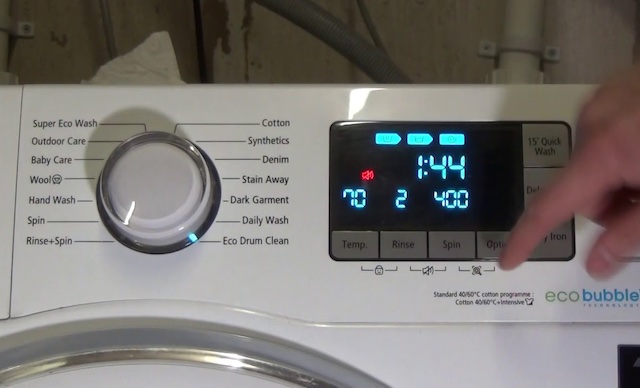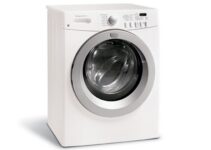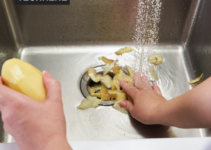Updated on January 16, 2023.
Your Samsung washer features several washing cycles for different types of clothing and materials. The washing cycle refers to two speeds. The first is the speed at which the washing machine tumbles the clothes and then another speed that spins the water out of the clothes.
There are a lot of cycles to choose from which might require a learning curve to get used to. In addition, your washing machine might have pre-set cycle and will automatically determine what temperature of the water and rinse to use.

Getting To Know Your Samsung Washing Machine
Samsung is a South Korea-based company that manufactures a broad range of consumer electronics and home appliances, including washing machines which are known for their sleek designs, advanced features, and innovative technologies. Some of the features that are commonly found on these washing machines include smart controls, automatic drum cleaning, and energy-efficient operation. These washing machines also come in a variety of sizes, styles, and colors, making it easy to find a model that fits your needs and preferences.
That said, it’s no wonder why many families opt to buy a smart washing machine by Samsung because of its quality and highly functional home appliance to make life so much easier.
Below, we have listed and explained Samsung Washing Machine Cycle and the best material to use for. You will also find the temperature at which they operate to ensure you get things right.
Types Of Samsung Washing Machine Cycles
Samsung washing machines offer a variety of wash cycle options to choose from, depending on the model. Some common options of Samsung washing machine cycles include:
- Normal: This cycle is designed for everyday loads of mixed fabrics and soiling levels.
- Heavy Duty: This cycle is designed for heavily soiled loads and is typically the longest cycle.
- Delicates: This cycle is designed for delicate fabrics and uses a gentle wash motion and lower water temperature.
- Quick Wash: This cycle is designed for small, lightly soiled loads and is typically the shortest cycle.
- Bedding: This cycle is designed for washing sheets, comforters and other large, bulky items.
- Sanitize: This cycle uses high water temperatures to eliminate bacteria and allergens.
- Permanent Press: This cycle is designed for synthetic and permanent press fabrics, and uses a cool-down period to prevent wrinkling.
- Drain & Spin: This cycle is designed to drain and spin clothes without a wash cycle.
These options may vary in specific models, but the majority of Samsung’s washing machines come with a similar set of cycle options.
Samsung Washing Machine Cycles Explained in Detail
Cotton – Suitable for cotton, bed linens, table linens, underwear, towels, or shirts. The washing time and the rinse count will automatically adjust according to the load. Typically, a 20 degrees Celsius wash in a 9 kg machine will last 3 hours 19 mins. A 60 degrees Celsius wash in a 9 kg machine will last 2 hours 25 mins. Actual timing will depend on the appliance.
E Cotton – Provides optimal performance with lower energy for cotton fabrics, bed linens, table linens, towels or shires. To save energy, the actual temperature may be lower than specified.
Synthetics – Suitable for blouses or shirts made of polyester (diolen, trevira), polyamide (perlon, nylon), or similar materials. This cycle (4kg) typically runs at up to 40 degrees Celsius and lasts for about 2 hours 25 minutes
Wool – Suitable for machine-washable wool for loads less than 2.0kg. The WOOL cycle will gently cradle and soak the material to protect the wool fibers from shrinkage/distortion. This cycle uses up to 40 degrees Celsius wash. A neutral detergent is recommended.
Spin – The spin cycle adds an additional spin process to effectively remove moisture from laundry
Denim – This cycle features a higher water level in the main wash and an extra rinse cycle to ensure that no powder detergent remains. This wash cycle usually operates up to 40 degrees Celsius.
Rinse + Spin – This wash cycle features an additional rinse process after applying fabric softener to the laundry.
Eco Drum Clean – This cycle cleans the drum by removing dirt and bacteria from the drum. It should be performed once every 40 washes with no detergent or bleach applied. Make sure the drum is empty when using this wash cycle and avoid using any cleaning agents for cleaning the drum.
Super Eco Wash – This low-temperature Ecobubble cycle helps reduce power consumption
15′ Quickwash – For lightly soiled garments in less than 2.0kg that you want to wash quickly. This cycle usually lasts approximately 15 minutes and uses up to 40 °C. When using this cycle, use less than 20g of detergent. Using more than 20g of detergent may leave a detergent residue. For liquid detergent, go for a max of 20ml.
Daily Wash – This cycle is for everyday items such as underwear and shirts
Delicates – This cycle is designed for fabrics, lingerie (silk), bras, and other handwash-only fabrics. This cycle gives the best performance when liquid detergent is used.
Dark Garment – For additional rinses and reduced spinning, this cycle will ensure that laundry is washed gently and rinsed thoroughly.
Bedding – This cycle works best for bedspreads, bed sheets, bedding covers, etc. To get the best results, wash only 1 type of bedding at keeping the load weight at a maximum of 2.0kg
Baby Care – This cycle features a high-temperature wash and will extra rinse to help remove the remaining detergent effectively. This wash can reach up to 90 °C
Outdoor Care – This cycle is intended for outdoor clothes, sportswear, and skiwear made of functional materials such as spandex, micro-fiber, and stretch. This wash can use up to 40 °C.
Super Speed – Improves completion time up to 1 hour for everyday items such as underwear and shirts. The timing of the cycle will depend on the water supply conditions and the load and type of laundry.
Drain / Spin – Select this cycle to drain the water and spin the drum of the washing machine.
Eco Drum Clean+ This cycle will clean the drum by removing dirt and bacteria from it. This cycle will also clean the rubber door gasket by removing dirt from the gasket. Users should run this cycle once every 40 washes with no detergent or bleach applied. You will receive a notification to run this cycle after every 40 washes. When using this cycle, ensure the drum is empty and avoid using any cleaning agents for cleaning the drum.
AI Wash – The AI Wash cycle adjusts the amount of detergent and the cycle according to the load and the soil severity. This cycle should be used alongside the Auto Dispense function. In some washing machines, this AI Wash will be named Auto Optimal Wash.
Common Problems In Samsung Washing Machine Cycles
Some common problems that can occur during a Samsung washing machine cycle include:
- Machine not starting: This can be caused by a number of things, including a power issue or a problem with the control panel.
- Machine not spinning or agitating: This can be caused by a problem with the belt, the motor, or the transmission.
- Water leakage: This can be caused by a problem with the door seal or the water pump.
- Unbalanced load: This can cause the machine to shake and make loud noises. To fix this problem, redistribute the clothes evenly in the drum.
- Error codes: Samsung washing machines have several error codes that can be displayed to indicate a problem. These codes can be found in the machine’s user manual.
- Drain issue: This too is a common problem with washing machines. Check if the drain is already clogged with detergent, or lint.
These are just a few examples of common problems that can occur with Samsung washing machines. If you are experiencing a problem with your machine, it’s recommended to check the user manual or the company website or reach out to customer support.
Troubleshooting Washing Cycles
If you’re experiencing problems with the length of a wash cycle on your washing machine, you could try performing a factory reset. The factory reset will clear the settings on the washing machine so you can start the washing cycle again or switch to another cycle.
To perform a reset, follow the steps below;
- Tap and hold the functions button for 3 to 5 seconds
- Select O or OK to confirm
- Turn the dial to the left 2 times, until you get to the Factory Reset option.
- Tap the O button to confirm.
- Turn the dial to select OK.
- Once you’ve performed the factory reset, the washing machine will automatically turn off.
Wrapping Up
It is essential to read through the user manual when using a washing cycle. Some washing cycles have a max load limit that might be half or less than the maximum capacity your washer can take. Going over the load limit might lead to an uneven wash, the washer being imbalanced, or stains on clothing.
Conclusion
Using correct cycles of your Samsung washing machine for the type of clothes and level of soiling is important for proper cleaning and to prevent damage to the clothes. Different cycles use different combinations of water temperature, agitation, and spin speed to handle different types of fabrics and levels of dirt.
In general, it can be said that using a Samsung washing machine is usually quite easy and straightforward, even for those who are not particularly familiar with appliances. Most machines have clear and intuitive controls, and many come with instructions or user manuals that can help you understand how to use the different cycles and features.
FAQ
What do the cycles mean on a Samsung washing machine?
A washing machine cycle refers to the specific settings or options that the machine uses to wash clothes. Different cycles may have different combinations of settings, such as wash temperature, spin speed, and duration, that are optimized for different types of clothing or fabrics.
What’s the Samsung washing normal cycle time?
The length of a normal cycle on a Samsung washing machine can vary depending on the specific model and the settings that you choose. On average, a normal cycle on a Samsung washing machine can take between 60 to 90 minutes. However, some models may have a quick wash cycle that can take as little as 30 minutes or a heavy-duty cycle that can take up to 2 hours. It’s recommended to check the user manual for the specific time of the normal cycle on the Samsung washer you have.
How long is the Samsung washer quick wash?
The time it takes for a quick wash cycle on a Samsung washer can vary depending on the specific model and settings. Normally, a quick wash cycle on a Samsung washer can take anywhere from 15 minutes to an hour.
Is it OK to wash clothes on quick wash?
It depends on the type of clothes and the level of soiling. Quick wash cycles are generally shorter and use less water and detergent, and are designed for lightly soiled items. If your clothes are heavily soiled or dirty, you may want to use a regular or heavy-duty wash cycle to ensure that they are thoroughly cleaned. Additionally, you should always refer to the care label on the clothes before washing them, as some materials may require a specific type of wash cycle or may not be suitable for machine washing at all.
Is 15 minute wash cycle enough?
A 15-minute wash cycle is generally considered to be a short wash cycle and may not be sufficient for heavily soiled clothes or heavily stained items. The effectiveness of a 15-minute wash cycle will also depend on the type of detergent you are using, the water temperature, and the agitation speed. In general, a longer wash cycle with a higher water temperature and faster agitation will be more effective at cleaning clothes.



![LG Portable Air Conditioner Not Cooling [Fixed] LG Portable Air Conditioner Not Cooling [Fixed]](https://techrene.com/wp-content/uploads/2022/05/lg-portable-air-conditioner-not-cooling-211x150.jpg)

